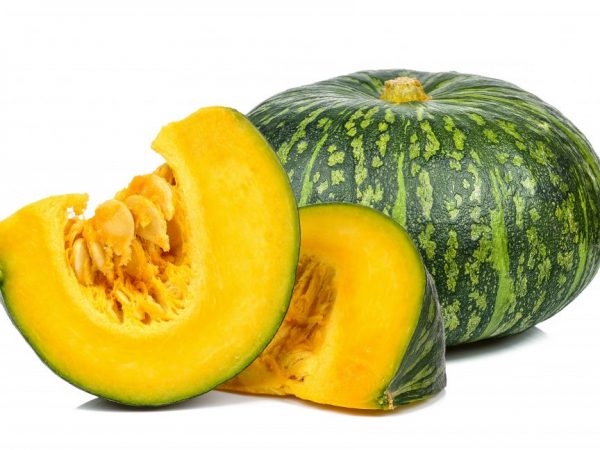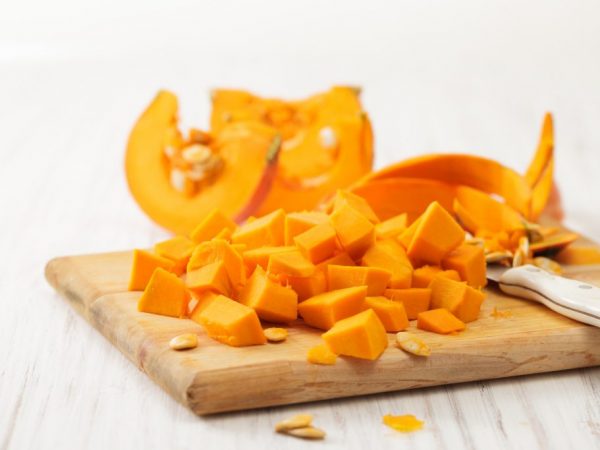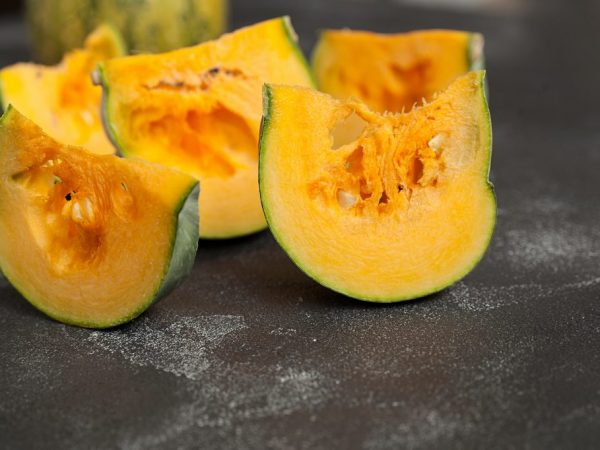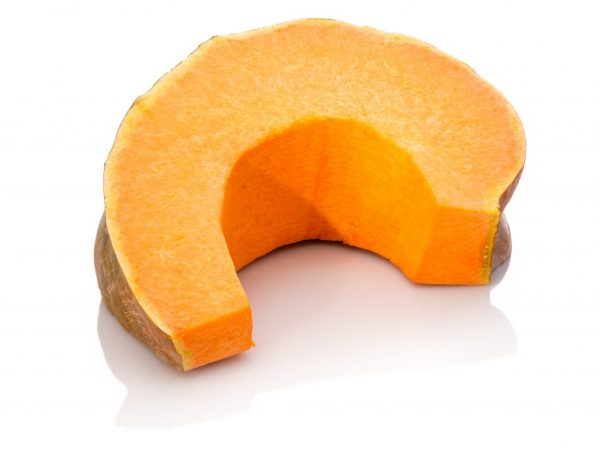What is the use of pumpkin
The health benefits of pumpkin are invaluable. Its chemical composition includes a variety of macro- and microelements, carbohydrates, vitamins and acids. It is an indispensable product in the diet. It is worth eating a vegetable in the recommended quantities and taking into account individual restrictions.
- The nutritional value
- The benefits of pumpkin
- Pumpkin leaves
- Raw
- Pumpkin nectar
- Boiled pumpkin
- Candied pumpkin
- Seeds
- Pumpkin inflorescences
- Practical use
- For the heart and blood vessels
- For the intestines
- For the liver and kidneys
- With diabetes mellitus
- For diseases of the gastrointestinal tract and digestive system
- For women's health
- For men's health
- For children's health
- In cosmetology
- Side effects and limitations
- Conclusion

The benefits of pumpkin
The nutritional value
Pumpkin, like zucchini, is one of the non-nutritive foods. Energy value: about 22 calories per 100 g.
Calorie content varies within acceptable limits depending on the type of use.
As part (per 100 g):
- 1 g protein;
- 0.1 g of organic acids and fats;
- 4.4 g carbohydrates;
- 2.0 g dietary fiber;
- 91.8 g of water;
- 0.6 g of ash.
The composition of pumpkin pulp contains, as in carrots, an increased amount of beta-carotene (30%).
Percentage of substances from the daily value:
- ascorbic acid - 8.9;
- pantothenic acid - 8;
- pyridoxine - 6.5;
- folates - 3.5;
- PP - 3.5;
- thiamine - 3.3;
- riboflavin - 3.3;
- alpha-tocopherol 2.7;
- choline - 1.6;
- phylloquinone - 0.9;
- biotin - 0.8.
The beneficial properties of pumpkin are contained in a large amount and variety of macro- and microelements. Percentage of substances from the daily value:
- silicon - 100;
- copper - 18;
- cobalt - 10;
- potassium - 8.2;
- molybdenum - 6.6;
- chrome - 4;
- magnesium - 3.5;
- phosphorus - 3.1;
- calcium - 2.5;
- iron - 2.22;
- fluorine - 2.2;
- zinc - 2;
- manganese - 2;
- sulfur - 1.8;
- chlorine - 0.8;
- iodine - 0.7;
- selenium - 0.5;
- sodium - 0.3;
- a small proportion of aluminum, boron, vanadium.
Of the carbohydrates in the chemical composition of pumpkin, there are mono- and disaccharides, glucose, sucrose, fructose and starch. Among the acids are saturated fatty acids (0.052 g), omega-3 (0.003 g), omega-6 (0.002 g).
The benefits of pumpkin

The vegetable has healing properties
Vegetable culture, depending on the type of preparation and consumption, can bring different healing properties for human health.
At the same time, they use pulp, pumpkin leaves, and seeds.
Usually, the peel is not used for food purposes.
Pumpkin leaves
The benefits of pumpkin foliage have long been proven. It is used in traditional medicine in the following cases:
- Against cancer. Phenolic compounds and chlorophyll, tannins and flavonoids, glycosides and saponins are indispensable components in the fight against cancer. They have antioxidant and anti-inflammatory properties and delay the formation and development of cancerous tumors.
- For cosmetic purposes. The foliage rich in ascorbic acid has a rejuvenating effect on the skin, ensuring a healthy appearance. Infusions and decoctions from the leaves have wound healing properties, activate the regeneration of tissue cells.The beta-carotene content supports healthy teeth and gums when used with an infused rinse.
- For diabetes control. Decoctions and infusions, due to their hypoglycemic effect, help diabetics maintain and control blood glucose levels. Water extracts with pumpkin ethyl acetate and polysaccharides act as an effective folk antidiabetic agent.
- For the immune system. The increased content of vitamin C acts as a source of production and maintenance of a high level of immunity, is the prevention of ARVI.
- Against seizures. Lotions with broths made from pumpkin leaves significantly enclose convulsive states.
Raw
The benefits of raw pumpkin are due to its chemical composition. All nutrients remain intact, because the vegetable does not undergo heat treatment.
Including fresh pumpkin in your diet is one way to saturate the body with all the nutrients.
Before use, you only need to peel it, it is most often used as an ingredient for salads.
Pumpkin nectar
Pumpkin nectar is another fresh vegetable derived product. It is recommended at night before going to bed, because helps to calm the agitated nervous system and acts as a natural sleeping pill.
Also, the juice is useful for:
- removal of puffiness;
- normalization of the liver and kidneys;
- normal functioning of the urinary tract.
Compresses based on it are an effective remedy for burns and mechanical damage to the skin, as well as in the treatment of eczema.
The healing properties of pumpkin nectar lie in the high content of ascorbic acid, therefore it is used as an additional alternative therapy in the treatment of colds.
Boiled pumpkin

Pumpkin helps to reduce excess weight
When boiled and steamed, pumpkin loses an insignificant composition of nutrients, but the largest amount remains, so it does not reduce its properties.
When boiled, pumpkin remains low in calories, is easily digestible, promotes weight loss, cleanses from slagging, and reduces puffiness. Therefore, it is indicated for people with irritated gastric mucosa and gastritis.
It is not recommended in boiled form:
- for diabetics, because with this processing, a sweet vegetable increases the glycemic index;
- with a weak intestine, because possesses laxative properties.
Candied pumpkin
Dried pumpkin is another low-calorie food that is beneficial to include in the diet against a number of diseases.
When dried, the vegetable retains most of the vitamin elements, and its storage is permissible for a long time.
Candied fruits have a beneficial effect on the digestive system, improve metabolic processes, act as a choleretic agent and help strengthen memory.
Dried chips and dried candied pumpkin fruits are not recommended for people with weak intestines, because this product improves intestinal motility and cleanses the stomach.
Seeds
Pumpkin seeds are used to make oil with a wide range of medicinal effects.
It contains a high proportion of protein components, a large amount of macro- and microelements that have a positive effect on the digestive, cardiac, endocrine and nervous systems.
Pumpkin seed oil is recommended for external use in the treatment of mucous membranes damaged by ulcers and erosion, has bactericidal and wound healing properties.
White cake from seeds and seed sprouts are used in folk medicine as a means of normalizing liver function in hepatitis, regulating kidney function.
It is useful to take them as a dietary supplement to lower cholesterol levels and cleanse the body.
Pumpkin inflorescences
Pumpkin flowers can be cured for coughs.
To this end, they are baked in a mixture with dough or a decoction is prepared from the inflorescences (2 tablespoons of flowers per 200 ml of water, boil for 5 minutes, insist 0.5 hours).Cakes with pumpkin inflorescences are eaten with severe coughing attacks.
Medicinal decoctions are drunk at 0.5 tbsp. 3 times a day before meals.
Practical use
For the heart and blood vessels

Vegetable increases blood clotting
Pumpkin is useful for diseases of the cardiovascular system, it prevents anemia and activates the formation of platelets, increasing blood clotting.
Acts as a vasodilator, lowering blood pressure, thinning rather than thickening the blood.
To strengthen blood vessels, it is recommended to eat a vegetable raw in the morning, on an empty stomach, in an amount of 250 g.
For the prevention of atherosclerosis, pumpkin inflorescences are suitable, which are poured with an alcohol solution and kept for 7 days. Take this tincture 20 drops 2 times a day.
The duration of the course without harm to the body is 10 days.
For the intestines
For chronic colitis and short-term constipation of the intestines, pumpkin dishes are included in the diet as a laxative.
Usually they make fresh salads from raw pumpkin (100 g), carrots (1 pc.) And apples (1 pc.), Season them with vegetable or olive oil and eat them in the morning or in the evening.
A vegetable boiled or stewed in oil, which is mixed with honey, has a similar laxative effect.
For the liver and kidneys
Pumpkin seed oil helps support liver function and kidney function - it has a cleansing effect, helping to remove harmful toxins. Take it for 1 tsp. in the morning on an empty stomach.
The duration of the course is no longer than 30 days. If necessary, repeat the course in a month.
For the treatment of liver disease, fresh pumpkin is infused with honey. To do this, the vegetable is cleaned inside, leaving the peel outside, and the space is filled with honey. Leave for 1.5 weeks in a dark, cool place.
The present pumpkin honey is consumed in 1 tsp. 3 times a day before each meal. The duration of the course without harm to the body is up to 3 weeks. Contraindications - intolerance to honey products.
With diabetes mellitus
Patients with diabetes and people prone to the accumulation of high blood glucose levels are not recommended to eat pumpkin dishes made from boiled or baked vegetables.
Only a fresh product can reduce sugar levels without harm to health, the glycemic index of which until the moment of heat treatment is only 25 units.
For diseases of the gastrointestinal tract and digestive system
Pumpkin dishes should be consumed in limited quantities for those who have inflammatory processes in the pancreas.
The vegetable is indicated only after the removal of attacks of pancreatitis and is used in a boiled form. The daily rate is up to 300 g. Juice is contraindicated.
With the existing gastritis and stomach ulcers, the vegetable is permissible for use raw or boiled, subject to restrictions. Among the contraindications is a reduced production of gastric juice.
For women's health

Raw pumpkin helps relieve toxicosis
Raw pumpkin has a calming effect on bouts of toxicosis in pregnant women, therefore, in small quantities, it is indicated for complicated pregnancies. Pumpkin seed oil is useful for external use for mastopathy.
For men's health
Pumpkin juice and seeds are a source of sexual activity for men, maintaining their potency and reproductive function at the proper level.
Rectal suppositories with pumpkin act as a remedy for impaired functioning of the prostate gland, they are used for prostate adenoma.
For children's health
High in fiber, pumpkin is an essential ingredient in baby food. It regulates the child's digestive work, helping to quickly absorb the beneficial elements obtained from food.
A large proportion of vitamin C improves immunity, ensuring the normal development of the child's body and its growth.
Pumpkin seeds have medicinal properties to get rid of worms.
In cosmetology
The boiled vegetable is applicable for cosmetic purposes. It is kneaded into gruel and applied to the face as a rejuvenating mask. Vitamins A and E present in the vegetable actively prevent the appearance of wrinkles and delay the aging process of the facial skin.
The same vitamins act as sources of nail health and have a beneficial effect on their quality, if you regularly cover the nail plates with pumpkin oil.
Side effects and limitations
Pumpkin harm is manifested with the following problems:
- violation of the acid-base level;
- high blood sugar (diabetes);
- diseases of the digestive system (gastritis, ulcers).
Some people experience bouts of flatulence. In such cases, the use of a vegetable by doctors is not contraindicated, but its amount in the diet should be limited.
Conclusion
The pumpkin family is a source of vitamins and minerals necessary for human health. You can eat fresh, boiled, dried. In this case, they use not only the fruits themselves, but also leaves, seeds and inflorescences. Indications for use are different.
When consumed in the recommended quantities, pumpkin is not harmful, however, there are a number of contraindications when it should not be included in the diet.

